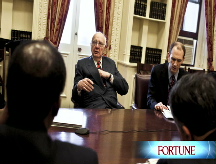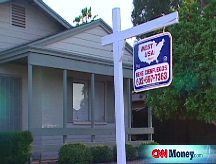Stimulus: Now for the hard part
A $787 billion economic recovery package became law on Tuesday with the simple stroke of Obama's pen. Knowing whether it's working? Not so easy.
NEW YORK (CNNMoney.com) -- President Obama on Tuesday signed the $787 billion American Recovery and Reinvestment Act into law.
But he's far from being able to declare "mission accomplished."
"Today does not mark the end of our economic troubles," Obama said before signing the bill at the Denver Museum of Nature and Science. "But it does mark the beginning of the end - the beginning of what we need to do to create jobs for Americans scrambling in the wake of layoffs; to provide relief for families worried they won't be able to pay next month's bills; and to set our economy on a firmer foundation."
Indeed, even though debate over the legislation was fraught with partisan fighting and what some characterize as strategic missteps by the nascent administration, getting the law passed was the easy part.
Far more difficult will be gauging whether the legislation's trademark initiatives - which include improving physical infrastructure, investing in energy projects and providing financial relief for families by way of tax cuts and increased government benefits -- are really doing the trick.
The first step is to stem the recession in the near term. In the longer term it will be to put the economy on a path to sustained growth and greater efficiencies in energy production, health care and other areas.
So how will we know if it's working? What will be the signs? The president and economists say the biggest marker will be an improvement in the jobs picture.
"That's bottom-line number one, because if people are working, then they've got enough confidence to make purchases, to make investments," Obama said last week before the bill's passage. "Businesses start seeing that consumers are out there with a little more confidence, and they start making investments, which means they start hiring workers. So step number one, job creation."
The official benchmark estimates from the White House: 3.5 million jobs will be created or saved over the next two years, and over 90% of them will be in the private sector. (See the White House's state-by-state estimates of how many jobs could be created or saved in the map at right.)
But measuring the numbers of jobs saved as a result of the economic recovery package promises to be an elusive task.
"It will be difficult to gauge the economic benefit of stimulus since we won't know ... how the economy would have performed without stimulus. Indeed I expect the economy to lose another 3 million jobs with stimulus but over 4 million without it," said Mark Zandi, chief economist at Moody's Economy.com, whose research was relied upon by lawmakers to make the case for the economic recovery package.
As for gauging how many jobs are created, economists say they will keep an eye on a number of measures.
Lakshman Achuthan, managing director the Economic Cycle Research Institute, said starting later this year he will look to what his group calls its Leading Employment Index as one gauge of stimulus effectiveness. The index is a composite of factors, including the number of initial jobless claims and hours in the average work week, as well as how many industries are adding jobs. As of January, the index was still falling, Achuthan said.
Another question Zandi said he will look at is to see whether job losses have begun to lessen by October or November.
"A key benchmark will be this fall. If stimulus is working as expected then monthly job losses should be closer to 250,000 per month, down from over 500,000 currently," Zandi said.
The ability to create or save jobs will depend in great part on business confidence. That's why, in addition to employment measures, Rich Yamarone, director of economic research at Argus Research, will keep an eye on small business confidence measures such as those put out by the National Federation of Independent Business.
Another sign of whether the rescue is working: Discretionary spending for activities like casino gambling and dining out, Yamarone said.
"When consumers start to feel better about their personal situation and employment prospects, they pick up the pace of spending - that usually extends to the discretionary items as well," Yamarone said.
Ultimately, even if every indicator of success for stimulus was tangible and could be measured with flawless precision, it will still be hard to issue a final verdict on whether the package has worked because its success is dependent on the success of other recovery efforts, such as the program for stemming foreclosures that Obama is expected to lay out on Wednesday.
"Stimulus by itself will not work well," Zandi said. "A financial stability plan and a foreclosure mitigation plan must also be implemented." ![]()




